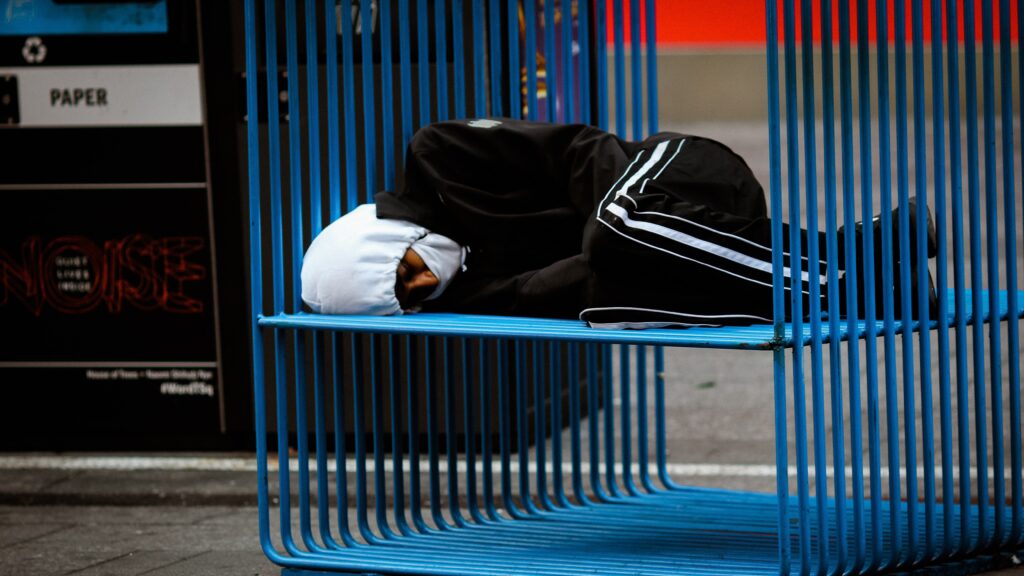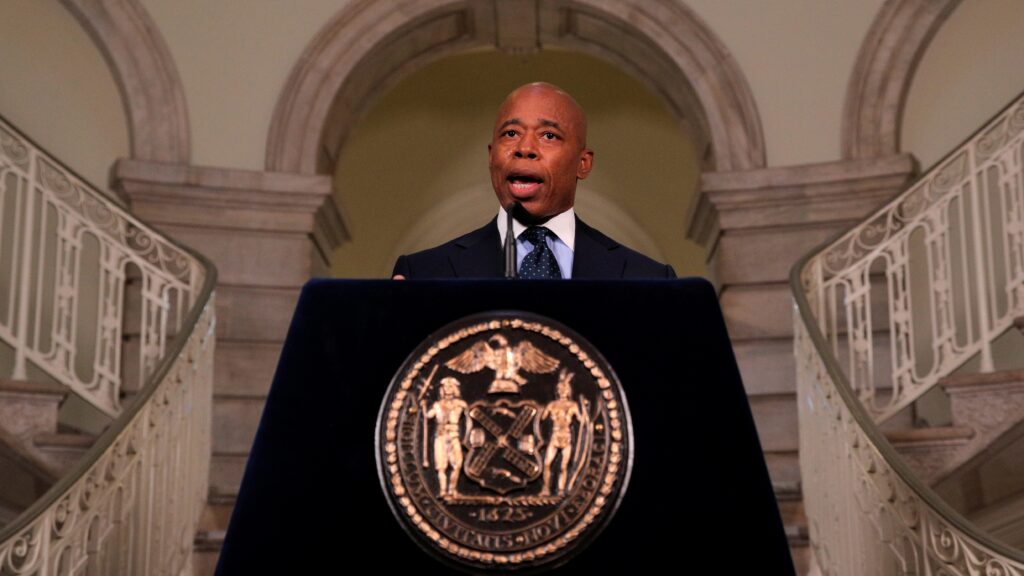Michelle Go never saw it coming.
The 40-year-old New Yorker, a financial consultant who volunteered to help the city’s homeless, had been awaiting the next R train at the Times Square station one Saturday morning last January when she was suddenly shoved from behind — pushed onto the tracks, where she was fatally struck by the oncoming train.
The suspect? A 61-year-old homeless man with a history of mental illness. The killing, one in a spate of random attacks in the city, has left many New Yorkers increasingly wary of the rise in homelessness in the city over the last decade.
New York City’s controversial Mayor Eric Adams, who took office last year just days before Go’s death, has staunchly advocated for removing homeless individuals from streets and subways. In November, he announced a directive to give first responders the power to involuntarily hospitalize unhoused individuals with mental illness, even if they are not harming others.
It’s an approach that has actually been on the books since 1999. In August of that year, New York State passed Kendra’s Law after a man with schizophrenia went off of his medication and pushed a woman named Kendra Webdale into the path of an oncoming train. Under Kendra’s Law, courts could mandate outpatient treatment to individuals who are a danger to themselves or others. Supporters of the law included several public safety and mental health advocacy groups like the National Alliance on Mental Illness. Fierce opponents, like the New York Civil Liberties Union, believed that involuntary hospitalization is a fundamental violation of human rights.
The city’s latest expansion of this law has caused heated debate among psychologists and homeless advocates alike, especially given that outward displays of violence are no longer a requirement to enact such serious measures.

“False sense of security”
Though Mayor Adams has pledged to address the critiques, opponents say there are too many gray areas, making this a counterproductive solution for a misdiagnosed problem.
“Institutionalization is not the answer here,” says Sarah Saadian, senior vice president of public policy and field organizing at the National Low Income Housing Coalition. “We need to be focusing on the best practices, which are helping people who have mental health conditions or substance use disorders get into housing and get the services and the resources they need, not involuntarily institutionalizing them.”
Deborah Padgett, professor at New York University’s Silver School of Social Work, is an expert on homelessness and mental illness. Hearing the city’s directive, she says, filled her with a sense of exasperation and déjà vu.
“To expand the powers of first responders only contributes to more mistrust, as the person with the serious mental illness is forcefully taken to psychiatric evaluation,” Padgett says. That in of itself can be re-traumatizing to these vulnerable individuals, she notes. “Research has shown that this approach does not work.”
Padgett argues that the system’s lack of psychiatric beds, likely months-long delays, and practices of neglect would only worsen existing issues and promote a “false sense of security.”
“To expand the powers of first responders only contributes to more mistrust, as the person with the serious mental illness is forcefully taken to psychiatric evaluation.”
A notion of a pipeline between mental illness and homelessness is a persistent, but inaccurate, narrative, Padgett explains.
In actuality, the relationship is hardly causal. Research shows that only about one-third of homeless individuals suffer from a serious mental illness, but concerns about public safety often arise because of mentally ill homeless individuals’ visibility. Forced treatment relies on inherent stereotyping, especially when the individual is not a threat to themselves or others.
“It’s not like mental illness causes homelessness,” says Steve Berg, chief policy officer at the National Alliance to End Homelessness. “What causes homelessness is the decision to not make housing available for everyone who needs it.”
“The structural or systemic issues, i.e., lack of affordable housing and increasing poverty, are far more causal than any particular individual problem,” Padgett says. Policy solutions to curb homelessness, then, must also address these structural and systemic issues, according to homeless advocates.
Systemic failures
Experts attribute the rise in New York’s homelessness — with an all-time high of 65,633 people sleeping in shelters — to the city’s failures in providing adequate employment, housing, shelters, mental health care and tenant protections. Rents in the city rose 15% from July 2021 to August 2022. As of November, the state’s attempts to restore 1,000 defunct psychiatric beds post-pandemic went largely unsuccessful.
“Elected leaders, over many years and over decades in some cases, have not taken it upon themselves to make sure there is enough housing for people with lower incomes, people in low wage jobs, people who have disabilities and can’t work,” Berg says. This institutional neglect of city residents, not mental illness, is what leads to homelessness.
Mayor Adams and supporters of the new initiative seem to have faith that they can overcome potential challenges, such as the overloaded system. Mitchell Katz, the director of the city’s public hospitals, told the New York Times last year that modifying existing treatment measures is “doable.”
But their approach relies on the idea that certain people cannot decide for themselves that they need help. “It is not acceptable for us to see someone who clearly needs help and walk past them,” Adams said in a statement.

Many psychologists, like Padgett, disagree. They argue that the best way to treat a person is to respect their own judgment about their condition, even if the psychiatrist believes they lack insight into the illness. Even those who have mental illness, they argue, have the right to bodily autonomy.
The best approach to treat mental illness among homeless populations, Padgett said, would be “to listen to the patient and accept their meanings about what is wrong and what type of help is needed. The research literature strongly suggests that this yields greater rapport and trust.”
While Adams is known for being a tough-on-crime Democrat, he will begin implementing special training for first responders to “ensure compassionate care.” Involving law enforcement in this respect may prove ineffective, as police interactions with unhoused individuals tend to escalate — often violently — and contribute to more mistrust.
When it comes to the rise in violence since the pandemic, Padgett’s research suggests that homeless individuals — with or without serious mental illnesses — are far more likely to be a victim than a perpetrator of violent acts.
Those who commit violent acts are often victims of neglect, deemed by themselves and others around them a lost cause, thus worsening their condition. “As horrible as the subway attack on Ms. Go was, such acts are quite rare,” says Padgett. “Violence, homicide are more frequently the province of the ‘sane.’”
Putting housing first
The bigger problem requires a political shift from treatment and shelters, which are breeding grounds for abuse and neglect, to “housing first” policies, experts and homelessness advocates argue.
A housing first policy would address the affordable housing crisis that has plagued New York City over the past few years, rather than its symptoms.
“Housing First is the most effective strategy for ending homelessness, period,” Saadian argues. “What Housing First means is that people are moved as quickly as possible into housing, and they’re connected to the voluntary support of services that they might need or want.”
“It’s not like mental illness causes homelessness. What causes homelessness is the decision to not make housing available for everyone who needs it.”
The housing first approach was developed in response to the earlier “stairstep” model, in which homeless individuals were required to meet certain benchmarks in order to qualify for housing. Saadian says the model yielded poor results: without homes, people struggled to meet the requirements and build lives of their own.
“Everybody deserves a home to live in, but also, the home is the platform that allows us to do so much else in our life,” Saadian says. “Many of us have mental health challenges, or substance use disorders, but it’s a lot easier to address and manage those issues if you’re in a home than if you’re sleeping outside. It’s a really practical approach as well, aside from a moral one.”
The movement for housing first policies has research on its side. Even in New York City, the Volunteers of America-Greater New York (VOA-GNY) already launched an Adams-endorsed pilot program last September, moving 80 unsheltered New Yorkers into supportive housing units. Adams’ confidence in this forward-looking endeavor is promising, but needs to be unwavering for its ultimate success.
Prevention, experts warn, is far more effective than applying bandages over an infected wound.
Correction: An earlier version of this article misstated the rate at which rents rose in New York and mistakenly described the stairstep model as the housing first approach. We regret the errors.

